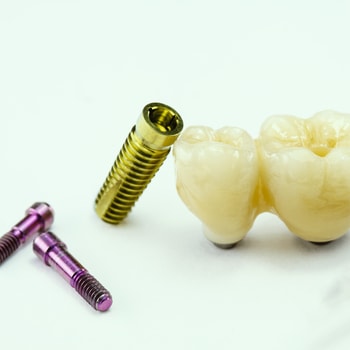Table of Contents
Maintaining optimal dental health is a cornerstone of overall well-being, and addressing tooth decay promptly is essential to prevent more severe dental issues. One effective solution for restoring damaged or decayed teeth is using silver crowns for teeth, also known as stainless steel crowns. Silver crowns offer a durable and cost-effective option for protecting and restoring tooth structure, whether for baby teeth in children or adults. This comprehensive guide explores everything you need about silver crowns, including their applications, benefits, procedures, and maintenance.
What Are Silver Crowns?
Silver crowns, or stainless steel crowns, are a type of dental crown made from a metal alloy that typically includes stainless steel, nickel, and chromium. These pre-fabricated crowns are designed to fit over a damaged or decayed tooth, providing protection and structural support. Silver crowns are particularly popular in pediatric dentistry for restoring baby teeth but can also be used for adult teeth in certain situations.
Types of Dental Crowns
Before delving deeper into silver crowns, it’s important to understand the various types of dental crowns available:
- Porcelain Crowns: Made from ceramic materials, porcelain crowns are tooth-colored and highly aesthetic, making them ideal for front teeth.
- Composite Resin Crowns: These are also tooth-colored and typically less expensive than porcelain crowns, but they may not last as long.
- Metal Crowns: These, including silver crowns, are made from metals like gold, platinum, or base metals. They are durable and resistant to wear but less aesthetic.
- Porcelain-Fused-to-Metal Crowns: These crowns combine the strength of metal with the appearance of porcelain, making them versatile options for both front and back teeth.
Benefits of Silver Crowns
 Silver crowns offer several advantages that make them a preferred choice in specific dental scenarios:
Silver crowns offer several advantages that make them a preferred choice in specific dental scenarios:
- Durability: Metal alloys used in silver crowns are exceptionally strong, making them highly resistant to wear and tear. This durability especially benefits back teeth with significant biting and chewing forces.
- Cost-Effective: Silver crowns are generally more affordable than porcelain and composite crowns, making them a practical option for restoring multiple baby teeth or treating extensive tooth decay.
- Ease of Placement: Silver crowns are pre-fabricated, allowing for quicker placement without extensive laboratory work. This efficiency is particularly advantageous in pediatric dentistry, where cooperation from young patients may be limited.
- Preventing Further Decay: By covering the entire chewing surface and surrounding areas, silver crowns effectively seal off spaces where bacteria and food particles can accumulate, thereby preventing further decay.
- Minimally Invasive: Compared to other types of crowns, the placement of silver crowns often requires less removal of healthy tooth structure, preserving more of the natural tooth.
When Are Silver Crowns Used?
Silver crowns are versatile and can be utilized in various dental treatments for both children and adults:
1. Pediatric Dentistry
In pediatric dentistry, silver crowns are commonly used to restore baby teeth that have been extensively damaged by tooth decay. Baby teeth play a crucial role in guiding the proper alignment of adult teeth as they erupt. Restoring baby teeth with silver crowns ensures that children maintain healthy oral development and prevents the need for more invasive treatments later on.
2. Permanent Teeth
While less common, silver crowns can also be used for permanent teeth in adults, particularly in cases where:
- Aesthetic concerns are minimal, such as back teeth, where visibility is limited.
- Cost considerations make metal crowns a more feasible option.
- The patient prefers a long-lasting solution without the need for frequent replacements.
3. Post-Root Canal Therapy
After a root canal procedure, a dental crown is often placed to protect the treated tooth. Silver crowns are a durable choice, ensuring the tooth remains intact and functional.
The Silver Crown Procedure
Understanding the procedure in placing a silver crown can help alleviate any concerns and provide a clear picture of what to expect during the treatment.
1. Initial Examination and Diagnosis
The process begins with a thorough examination by the dentist or pediatric dentist. Using X-rays and clinical evaluations, the dentist assesses the extent of tooth decay or damage and determines whether a silver crown is the appropriate treatment option.
2. Preparation of the Tooth
For baby teeth, the procedure is typically quick and straightforward. The dentist removes the decayed or damaged portion of the tooth, ensuring that all affected areas are cleaned thoroughly. In some cases, a filling material may be used to restore the tooth before placing the crown.
3. Fitting the Crown
Silver crowns come in pre-formed shapes and sizes. The dentist selects the best-fitting crown for the prepared tooth. The crown is then adjusted to ensure a snug and comfortable fit. Because silver crowns are pre-fabricated, this step is relatively quick compared to custom-made crowns.
4. Cementing the Crown in Place
Once the silver crown fits properly, the dentist uses a special dental cement to secure it to the tooth. The cement hardens quickly, ensuring the crown stays in place during daily activities like eating and chewing.
5. Final Adjustments and Polishing
After the crown is cemented, the dentist may make final adjustments to ensure the patient’s bite is comfortable and has no rough edges. The crown is then polished to a smooth finish, enhancing functionality and appearance.
Are Silver Crowns Safe?
When properly placed by a qualified dental professional, silver crowns are considered safe and effective for both baby and permanent teeth. The materials used, primarily metal alloys, are biocompatible, meaning they do not cause adverse reactions in the mouth. However, as with any dental procedure, you must consult your dentist to determine the best treatment option based on individual needs and health conditions.
Safety Considerations
- Allergic Reactions: Some individuals may have allergies to metals used in silver crowns, such as nickel. It’s important to inform your dentist of any known metal allergies before the procedure.
- Oral Hygiene: Maintaining good oral hygiene is crucial to prevent plaque buildup around the crown, which can lead to gum disease and tooth decay.
- Regular Check-ups: Regular dental visits ensure that the silver crowns remain intact and functional and any potential issues are addressed promptly.
Pros and Cons of Silver Crowns vs. Other Types
When considering dental crowns, it’s important to weigh the benefits and drawbacks of each type to determine which is best for your needs.
Pros of Silver Crowns
- Durability: Highly resistant to wear and tear, making them ideal for back teeth.
- Cost-Effective: More affordable compared to porcelain and composite crowns.
- Quick Placement: Pre-fabricated crowns allow for faster treatment times.
- Prevents Further Decay: Seals off buccal pits and other vulnerable areas, reducing the risk of tooth decay.
Cons of Silver Crowns
- Aesthetic Concerns: The metallic appearance may be less desirable, especially for front teeth.
- Potential for Allergies: Some individuals may be allergic to the metals used.
- Permanent Appearance: Metal crowns cannot be easily removed or altered once placed.
Comparison with Other Crown Types
- Porcelain Crowns: Offer superior aesthetics but are more expensive and may not be as durable as metal crowns.
- Composite Resin Crowns: Tooth-colored and aesthetically pleasing but generally less durable and may require more frequent replacements.
- Porcelain-Fused-to-Metal Crowns: These crowns combine the strength of metal with the appearance of porcelain, offering a balanced solution for durability and aesthetics.
Are Silver Crowns Safe for Baby Teeth?
Silver crowns are widely regarded as safe and effective for baby teeth. They provide a robust solution for restoring decayed or damaged teeth in children, ensuring that permanent teeth develop properly and remain healthy. By using silver crowns, pediatric dentists can address significant tooth decay without compromising the integrity of the developing tooth.
Benefits for Children
- Protection: Silver crowns protect the remaining tooth structure from further decay.
- Functionality: Restores the tooth’s ability to chew and speak properly.
- Longevity: Durable enough to last until the natural adult tooth erupts.
Considerations
- Growth: Baby teeth will eventually be replaced by permanent teeth, so the crown should not interfere with the natural eruption process.
- Comfort: Ensuring the crown fits well and does not cause discomfort is crucial for children’s compliance with oral hygiene practices.
Are Silver Crowns Safe for Adult Teeth?
While silver crowns are primarily used for baby teeth, they can also be employed for adult teeth in specific scenarios. Their durability makes them suitable for back teeth that handle substantial chewing forces. However, the aesthetic limitations may make them less appealing for front teeth or highly visible areas.
Situations for Using Silver Crowns in Adults
- High Decay Areas: Silver crowns are ideal for tooth decay in back teeth where appearance is less of a concern.
- Budget Constraints: They offer a cost-effective solution compared to expensive crown types like porcelain.
- Temporary Solutions: In some cases, silver crowns may be used temporarily until a more permanent, aesthetically pleasing crown can be placed.
 How Do Silver Crowns Prevent Further Decay?
How Do Silver Crowns Prevent Further Decay?
Silver crowns play a pivotal role in preventing further decay by covering the entire chewing surface and protecting the buccal pits of natural teeth—small depressions on the outer surfaces of teeth where plaque bacteria often accumulate. By sealing these vulnerable areas, silver crowns eliminate spaces where bacteria and food particles can reside, reducing the risk of new cavities.
Protective Barrier
The silver caps acts as protective barrier, shielding the underlying tooth structure from acids produced by plaque bacteria. This barrier is crucial in maintaining the tooth’s health and preventing decay from progressing into the inner layers.
Maintenance of Oral Hygiene
Maintaining good oral hygiene becomes more manageable with a silver crown in place. The smooth surface of the crown is easier to clean, and the absence of decayed areas minimizes the risk of bacterial growth. However, regular brushing and flossing are still essential to keeping the surrounding gum line and adjacent teeth healthy.
Conclusion
Silver tooth crowns offer a robust and cost-effective solution for restoring decayed or damaged teeth, particularly in baby and adult back teeth. Their durability and protective qualities make them reliable in pediatric dentistry and general dental care. While they may not offer the same aesthetic appeal as tooth-colored crowns, their functionality and affordability make them an invaluable option for maintaining oral health.
Understanding the benefits, procedures, and maintenance of silver crowns can help patients make informed decisions about their dental care. Whether addressing significant tooth decay, protecting weakened teeth, or restoring functionality, silver crowns play a critical role in preserving a smile’s natural beauty and health.
If you or your child requires a silver crown, consult a qualified pediatric dentist or general dentist to determine the best treatment plan tailored to your needs. With proper care and regular dental visits, silver crowns can provide lasting protection and support for a healthy, radiant smile.
References
https://jada.ada.org/article/S0002-8177(21)00616-4/fulltext
https://www.ncbi.nlm.nih.gov/pmc/articles/PMC7387869/
https://www.researchgate.net/publication/377562173_Stainless_Steel_Crown_A_Review_Article
